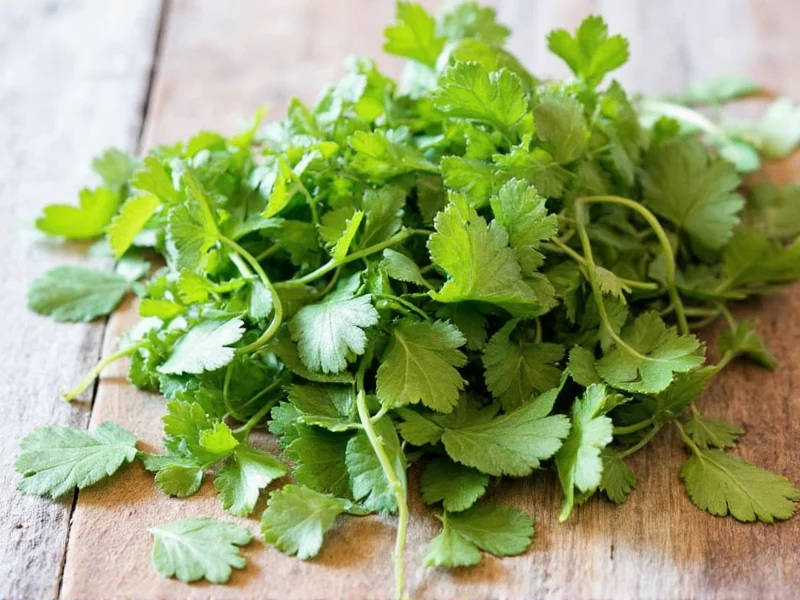Understanding Coriander and Its Unique Flavor Profile
Before exploring coriander substitutes, it's crucial to understand what makes this herb special. In American English, “coriander” refers to both the fresh leaves (commonly called cilantro) and the dried seeds. Internationally, “coriander” typically describes the entire plant. The leaves offer a bright, citrusy flavor with subtle peppery notes, while the seeds provide warm, nutty undertones essential in spice blends.
When you're searching for what can i substitute for coriander in your cooking, the right alternative depends on whether you need fresh leaves or dried seeds. Many home cooks face this dilemma when following international recipes without access to specialty ingredients. Understanding flavor chemistry helps you make informed substitutions that preserve your dish's integrity.
Top 5 Fresh Coriander Leaf Substitutes
When your recipe calls for fresh coriander leaves (cilantro), these alternatives deliver the closest flavor matches while maintaining proper texture and aroma. Each substitute works better in specific culinary contexts, so choose wisely based on your dish type.
| Substitute | Ratio | Best For | Flavor Notes |
|---|---|---|---|
| Parsley (flat-leaf) | 1:1 | Mexican, Mediterranean dishes | Milder, grassier flavor; lacks citrus notes |
| Culantro | 1:1 (use less if sensitive) | Caribbean, Latin American, Asian cuisine | Stronger, more pungent than cilantro |
| Basil + Lime Zest | 1 cup basil + 1 tsp zest | Thai, Vietnamese dishes | Sweet herbal notes with citrus brightness |
| Mint + Dill | 2 parts mint, 1 part dill | Middle Eastern recipes | Cooling effect with subtle anise notes |
| Green Onion Tops | 1:1 | Stir-fries, garnishes | Mild onion flavor without citrus |
Parsley: The Most Accessible Alternative
Flat-leaf parsley serves as the most widely available coriander substitute for Indian cooking when cilantro isn't an option. While it lacks the distinctive citrus notes, its similar texture works well in salsas, chutneys, and as a garnish. For better flavor approximation, add a squeeze of lime juice to mimic coriander's bright acidity. This combination proves particularly effective when you need what can i substitute for coriander in curry recipes.
Culantro: The Flavor Twin
Often confused with cilantro, culantro (Eryngium foetidum) grows as a single broad leaf rather than delicate fronds. Its flavor profile closely matches coriander but with intensified potency—some describe it as “cilantro on steroids.” Use half the amount initially, then adjust to taste. This substitute shines in sofrito, jerk seasoning, and when you're looking for a coriander leaf substitute alternatives for Caribbean dishes.
Dried Coriander Seed Substitutes
When your spice cabinet lacks dried coriander seeds, these replacements maintain your recipe's aromatic complexity. Unlike fresh leaf substitutions, seed alternatives focus on warm, earthy notes rather than bright citrus flavors.
Cumin: The Closest Match
Use cumin at a 1:1 ratio for dried coriander seeds in curry blends, stews, and marinades. While cumin offers earthier tones with less citrus, it provides similar warm undertones. For better approximation in Indian recipes, combine equal parts cumin and coriander substitute caraway seeds. This approach works well when searching for coriander substitute for indian cooking solutions.
Caraway Seeds: The Underrated Option
Caraway delivers comparable warm, slightly citrusy notes with a hint of anise. Use at a 1:1 ratio in breads, sauerkraut, and European dishes where coriander seeds typically appear. Toast lightly before grinding to enhance flavor complexity. This substitute proves valuable when you need how to replace coriander in recipes requiring seed alternatives.
Cuisine-Specific Substitution Guide
The ideal coriander replacement varies significantly by culinary tradition. Understanding these distinctions prevents flavor mismatches that could ruin your dish.
Mexican and Latin American Cuisine
For tacos, guacamole, or pico de gallo, use flat-leaf parsley with added lime juice. The parsley provides necessary texture while lime restores missing citrus notes. Avoid strong substitutes like culantro here, as its intense flavor overpowers delicate salsas. This solution directly addresses coriander herb substitute for mexican food requirements.
Asian Dishes
In Thai and Vietnamese recipes, combine Thai basil with mint and a squeeze of lime. The basil's sweet anise notes complement coconut-based curries better than parsley alone. For pho garnish, use culantro sparingly—its robust flavor withstands hot broth better than delicate cilantro.
Middle Eastern and Indian Cooking
When making chutneys or raita, try a blend of mint and dill with lemon zest. For spice blends requiring dried coriander seeds, use equal parts cumin and caraway. This combination works particularly well for those seeking dried coriander substitute fresh conversions in complex spice mixes.
When Substitutes Won't Work
Certain dishes rely so heavily on coriander's unique chemistry that substitutions fundamentally alter the recipe. These include:
- Traditional chimichurri (coriander's citrus notes are irreplaceable)
- Certain Indian chutneys where coriander provides essential balancing acidity
- Some Vietnamese pho variations where fresh cilantro is integral to the aromatic profile
In these cases, consider modifying your recipe rather than forcing an unsuitable substitute. Sometimes understanding coriander vs cilantro substitution limitations prevents culinary disappointment.
Creating Your Own Custom Blend
For the most versatile best replacement for fresh coriander, create a multi-purpose blend:
- 2 parts flat-leaf parsley
- 1 part fresh mint
- 1 tsp lime zest per cup of herbs
- Small pinch of celery seed (optional for depth)
Store this mixture in an airtight container with a damp paper towel for up to three days. The combination delivers texture similar to cilantro with layered herbal notes that approximate coriander's complexity better than single-ingredient substitutes.











 浙公网安备
33010002000092号
浙公网安备
33010002000092号 浙B2-20120091-4
浙B2-20120091-4